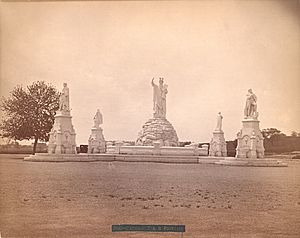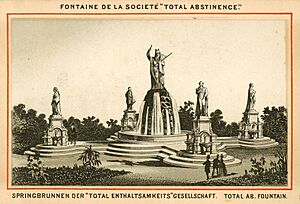Catholic Total Abstinence Union Fountain facts for kids
Quick facts for kids Catholic Total Abstinence Union Fountain |
|
|---|---|
 |
|
| Artist | Herman Kirn, designer & sculptor Thomas McElwee, portrait medallions Isaac H. Hobbs & Son, architects |
| Year | 1874-77 |
| Type | Fountain and water fountain |
| Location | Avenue of the Republic & States Street, West Fairmount Park, Philadelphia, Pennsylvania |
The Catholic Total Abstinence Union Fountain is a historic fountain in Fairmount Park in Philadelphia, Pennsylvania. It was also known as The Catholic Total Abstinence Centennial Fountain or The Centennial Fountain. This large fountain was built between 1874 and 1877. It was a special attraction for the Centennial Exposition in 1876. This big event celebrated 100 years since the United States became a country. The fountain was ordered by the Catholic Total Abstinence Union of America. This group encouraged people to live a life free from alcohol.
Contents
Building the Fountain: A Symbol of Values
This fountain was designed to show important ideas. It represented the strength of faith and the value of self-control. It also showed the Irish Catholic love for their country and freedom.
Who Designed the Fountain?
The fountain was designed by Herman Kirn. He was a sculptor from Philadelphia, born in Germany. Kirn came to the U.S. when he was six years old. He later went back to Germany to study art. His teacher, Carl Johann Steinhäuser, helped him get this important job.
Kirn created other artworks in Fairmount Park. These include a statue of William Penn from 1883. He also made a drinking fountain called Orestes and Pylades in 1884. Sadly, Kirn was hurt while building this last piece. A falling stone injured his right arm. After that, he worked for the Park.
Creating the Statues
Herman Kirn first showed a large model of the fountain in 1874. It was made of plaster of Paris. Raising money for the project took some time. Kirn officially got the job in the fall of 1874. The statues were carved from special marble from South Tyrol in Austria. Kirn moved there to work on them.
What the Fountain Looks Like
The fountain has a wide base made of granite. It is shaped like a Maltese cross and is 100 feet wide. In the middle is a large basin, 40 feet across. A 15-foot statue of Moses stands in the center. Moses holds the Ten Commandments and points to the sky. He stands on a marble mound that looks like a beehive. This mound represents the Rock of Horeb. In the Bible, God told Moses to strike this rock to bring water for his people.
Water for the fountain came from a reservoir on George's Hill nearby. Small waterfalls flowed from the rock mound. The outer wall of the basin has six small statues. These show important Roman Catholics who fought in the American Revolution. They include George Meade, Count Casimir Pulaski, and the Marquis de Lafayette. The seal of the Total Abstinence Union is also on the wall.
Outside the basin, on the arms of the cross, are four large statues. These are of important American Roman Catholics. They include Archbishop John Carroll, Charles Carroll of Carrollton, Father Theobald Mathew, and Commodore John Barry. Each statue has a granite base with four lion-head spouts. Water flowed from these, creating sixteen drinking fountains in total.
Fountain Dedication: A Grand Celebration
The fountain was officially opened on July 4, 1876. This was a very special day. First, there was a church service at the Cathedral of Saints Peter and Paul. Then, more than 5,000 people marched in a parade. They walked to the Centennial fairgrounds.
Composer Edward Mack wrote a special song for the event. It was called the "Centennial Fountain Grand March." Important Catholic leaders gave speeches. Father James O'Reilly gave a final blessing. He asked God to bless the fountain and those who used its water.
The fountain was working for the dedication. All sixteen drinking fountains had water. However, only the statue of Commodore Barry was in place. The other four statues were still being finished in Austria. The fountain stayed like this until the exposition closed in November 1876.
The statues of Father Matthew, Archbishop Carroll, and Charles Carroll of Carrollton were added later. They were dedicated on March 17, 1877, which is Saint Patrick's Day. The main statue of Moses Striking the Rock of Horeb was dedicated on July 4, 1877.
Later Years of the Fountain
The statue of Father Matthew was damaged by lightning on June 18, 1910. The sculptor, Herman Kirn, who had made it 35 years earlier, repaired it himself.
Images for kids











